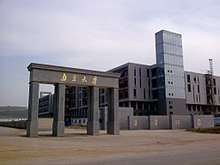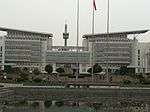Xianlin University City
Xianlin University City (simplified Chinese: 仙林大学城; traditional Chinese: 仙林大學城; pinyin: Xiānlín dàxuéchéng) is an area in Nanjing, Jiangsu province, with a number of universities.[1] It is located to the northeast of Purple Mountain.

History
The university city was an undeveloped, rural property in 1989, and multi-storied buildings were built there as the city grew. In 2001 the area was named Xianlin University City.[2]
In November 2011, an Undergraduate Education Teach Council was established by Nanjing Normal University, Nanjing University, Nanjing University of Finance and Economics, Nanjing University of Posts and Telecommunications, and Nanjing University of Chinese Medicine. The council was created to promote modern higher education practices to attract international university students and keep pace with new trends in education.[3]
A College of Geography Science, Nanjing Normal University study was conducted in 2011 to evaluate different aeration methods for removing high levels of nitrogen from a heavily polluted river in the Xianlin University Town.[4]
The “Xianlin Science City Development Consortium” was formed by 12 universities on February 25, 2012, to cooperate on research, sharing resources, event planning and the development of a "science city", with each university having its own science facilities.[5]
Vice Major of Nanjing, Lu Bing, is responsible for the oversight of the Management Committee of Xianlin University City as of 2014.[6]
Education
 | |
Clockwise from top
| |
Higher education organizations within Xialin University City include:
- Nanjing College of Information Technology[7]
- Nanjing Foreign Language School, Xianlin Campus[8]
- Nanjing Forest Police College[9]
- Nanjing Normal University[3]
- Nanjing Medical University
- Nanjing University's Xianlin campus[3]
- Nanjing University of Chinese Medicine[3][10]
- Nanjing University of Finance and Economics[3]
- Nanjing University of Posts and Telecommunications[3]
- Nanjing University of Zijin
- Yingtian Vocational Technical College
- Zhongbei College[11]
The area around the Xianhe East States was planned as a scenic residential community. Nanjing University is also a housing zone. Nanjing Sports Institute and Nanjing Normal University Station are commercial and business centres.[12] University and college graduates then become a pool of potential employees and researchers for the city's employers, such as organizations located within the Nanjing Economic and Technological Development Zone.[13]
Transportation
Transportation options include Line 2 of the Nanjing Metro.[12]
References
- 南京仙林大学城. Njxl.gov.cn (in Chinese). Retrieved May 17, 2014.
- Institute of Electrical and Electronics Engineers. IGARSS 2005: 25th Anniversary: Harmony between man & nature, IEEE International Geoscience and Remote Sensing Symposium, 25–29 July 2005, Seoul Korea. IEEE; 2005. ISBN 978-0-7803-9050-8. p. 251.
- Nanjing undergraduate education teaching council of Nanjing Xianlin University Town was established. Archived May 17, 2014, at the Wayback Machine Jiangsu Education. Jiangsu Provincial Department of Education. Retrieved May 17, 2014.
- Huan Jing Ke Xue. "Effect of different aeration ways on migration and transformation of nitrogen in heavily polluted urban river." National Center for Biotechnology Information, U.S. National Library of Medicine. October 2011. 32(10):2971-8. Retrieved May 17, 2014. PMID 22279911.
- Twelve Universities in Xianlin of Nanjing Establish a Development Consortium. Archived May 17, 2014, at the Wayback Machine Jiangsu Education. Jiangsu Provincial Department of Education. Retrieved May 17, 2014.
- Government Affairs, Leadership, Lu Bing. Archived May 17, 2014, at the Wayback Machine Government of Nanjing. Retrieved May 17, 2014.
- Introduction to NJCIT. Nanjing College of Information Technology. Retrieved May 17, 2014.
- Main page. Archived May 17, 2014, at the Wayback Machine Nanjing Foreign Language School, Xianlin Campus. Retrieved May 17, 2014.
- Brief Introduction. Archived April 6, 2014, at the Wayback Machine Nanjing Forest Police College. Retrieved May 17, 2014.
- Campus Introduce. Archived May 17, 2014, at the Wayback Machine Nanjing University of Chinese Medicine. Retrieved May 17, 2014.
- College in Brief. Archived May 17, 2014, at the Wayback Machine Zhongbei College. Retrieved May 17, 2014.
- Roger L. Mackett; Anthony D. May; Masanobu Kii. Sustainable Transport for Chinese Cities. Emerald Group Publishing; 2013. ISBN 978-1-78190-475-6. p. 286.
- Nanjing Economic and Technological Development Zone. China Internet Information Center. Retrieved May 17, 2014.
